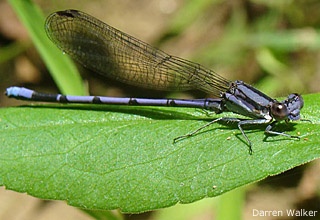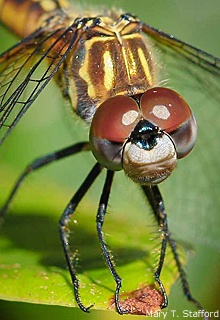We have much more to do and your continued support is needed now more than ever.
Damselflies, Dragonflies and Unexpected Discoveries

Impromptu Exploration
“Why would someone leave their trash here?” my 7-year-old asked when we arrived, pointing to a plastic container in the water. We fished it out but decided quickly that the litter had a higher purpose: It was a tool for parent and child explorers.
My son was the designated scooper, repeatedly gathering cupfuls of water. Those that included aquatic critters left him gleeful. The tadpoles eluded us (too swift!), but we enjoyed close-up views of water striders and other wee creatures in our hour spent observing. One so fascinated us that we took it home to ID it: a damselfly nymph, according to the books and websites we referenced.
After returning the nymph to the stream to complete the aquatic portion of its life cycle, we paused to admire the adult damselflies and dragonflies as they perched and flew by, and we talked about the differences between them. We also promised each other we’d be back to explore another day—our hideout in plain view. The location isn’t safeguarded, but our memories are.
What’s the Difference? Damselflies vs. Dragonflies

Fictional dragons are large compared to their fair maiden, or damsel, counterparts—and the same goes for these close cousins of the insect world.
- Damselflies usually have thin bodies, while dragonflies tend to be stouter.
- When perching, damselflies hold their wings together or partially spread, while dragonflies typically rest with their wings open.
- Among the other differences: Dragonfly eyes meet at or near the top of the head, while damselfly eyes are set apart.
We regularly see both types of odonates when we’re out and about. Do they visit your neighborhood too? I hope so. They’re lovely to behold.
Find out how to attract these aerial acrobats to your garden.




















